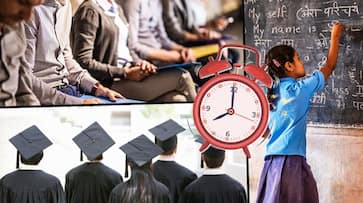While the world progresses to make our economies driven by artificial intelligence, the children of India still fail to receive primary education.
When I was a student in Zurich, my eyes were opened to what a beauty public education system can be.
And do you know why?
Because the government of Switzerland invests heavily in its education system, they spend at least 5.6% of their GDP on education. This degree of spending on a per capita basis makes Switzerland the first country in the world to do so. The unique feature of the Swiss education system is that it has incorporated practice-oriented training into their university education, and this dual system enhances the capacities of the students in innovation and creativity. The testimony for the success of this system lies in the fact that they have meagre unemployment rates and most students get placed directly from the universities into MNCs, and I was one of them. I was a beneficiary of this fantastic education system.
A significant part of my education was in India, and I will not sugar-coat the experience. It is now time to let go of our rose-tinted glasses and realize that there is a massive problem with our education system and our schools are the proof of that. The Constitution of India guarantees our right to education; however, both the curriculum and the standards are much below par.
We have been very slow in responding to the needs and wants of our students. Our school infrastructure has been failing in almost all states, and the teachers are not even qualified to teach our children. Over 30% of government teachers do not have a proper degree. Over 40% of government schools do not have adequate infrastructure and basic necessities such as electricity. We have heard many stories of children who are given a freeway to cheat and sometimes even teachers being pally with them. This is, in fact, well documented even in movies. We have read heart-wrenching news on children being asked to sweep floors, serve food and children being subjected to harsh punishments. However, when it comes to learning, the children are left far behind. In the last decade, we have seen primary education focusing just on the ability of the children to read and do basic math. But even this seems to a challenging task in India as almost half of our children are unable to read Grade 2 text or do basic subtraction. None of these skills is enough for the children to help them in higher education or to gain employment. According to the Annual Status of Education Report (ASER) 2019, many Grade 1 children were unable to solve fundamental math problems. Problems are as simple as 3+5. Over 25% could not answer application-based issues such as how many toffees they’d have if given three toffees in addition to the five toffees they already have.
Despite the historic Right to Education (RTE) Act of 2009, which ensured that our fundamental right under Article 21-A of the constitution is realised, our education system has failed us. Section 3 of the Act explicitly tells us that all children between the ages of six and fourteen should receive elementary education. However, the focus has always been on enrolment to meet targets, and it has never been on education. The teachers are not well-trained; they are not even aware of the subjects they teach. The teachers do not understand the needs of the students and just rely on notes and mugging up.
As per statistics, only 9.5% of the government schools comply with the RTE Act. According to Section 7 of the RTE Act, all funds required by government schools to provide education to children and for all other needs as mentioned by the act will be provided by the government. However, we still see that governments behave like a miser when it comes to spending on education. Even way back in the 1960s, the Kothari Commission had suggested that the government should allot 6% of its GDP to education but even till date we spend less than 4%. So, how do we even expect our education system to deliver results?
However, even the Right to Education Act is not enough as it just caters to children aged six to fourteen and ignores a massive pool of students at the mercy of nature. A look at the employment statistics will tell you why! When 40% of our youth, some of whom hold a master’s degree, fail to find a full-time job, we should all take a step back and re-evaluate our education system. The failure of our education system forces these children to take up employment at a paltry salary, and these jobs often follow a “Hire and Fire” policy, forcing them into deprivation. And there starts the vicious cycle of poverty in our society. Education is a basic necessity for everyone to live a life of dignity. And this should be provided by the government.
So, the effort required to change this condition of our education system seems to be nothing but Herculean. But this is not impossible. We need to increase both the access and the breadth of our education system, particularly and most importantly, primary education. We need to expand and strengthen the network of affordable schools and childcare. We all need to focus together to ensure that our children develop the necessary cognitive skills, social-emotional skills, alongside the academic skills that they are required to have.
Last Updated Feb 21, 2020, 2:04 PM IST









![Salman Khan sets stage on fire for Anant Ambani, Radhika Merchant pre-wedding festivities [WATCH] ATG](https://static-gi.asianetnews.com/images/01hr1hh8y86gvb4kbqgnyhc0w0/whatsapp-image-2024-03-03-at-12-24-37-pm_100x60xt.jpg)
![Pregnant Deepika Padukone dances with Ranveer Singh at Anant Ambani, Radhika Merchant pre-wedding bash [WATCH] ATG](https://static-gi.asianetnews.com/images/01hr1ffyd3nzqzgm6ba0k87vr8/whatsapp-image-2024-03-03-at-11-45-35-am_100x60xt.jpg)


